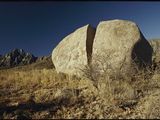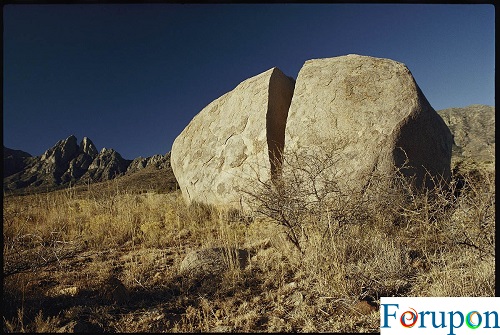weathering
Weathering describes the breaking down or dissolving of rocks and minerals on the surface of the Earth. Water, ice, acids, salts, plants, animals, and changes in temperature are all agents of weathering.
Riesling Cave
For upon |Weathering is the breaking down or dissolving of rocks and minerals on Earth’s surface. Once a rock has been broken down, a process called erosion transports the bits of rock and minerals away. Water, acids, salt, plants, animals, and changes in temperature are all agents of weathering and erosion. All went to work on this ancient mural, eroding on the wall of Riesling Cave in Upper Mustang, Nepal.
Farmer
As it smoothes rough, sharp rock surfaces, weathering, and erosion are often the first steps in the production of soils. Tiny bits of weathered minerals mix with plants, animal remains, fungi, bacteria, and other organisms. Weathered materials from a collection of rocks are richer in mineral diversity and contribute to more fertile soil, like this garden outside the Wolong Nature Reserve, China.
Weathered Rock
Mechanical weathering, also called physical weathering and disaggregation, causes rocks to crumble. This boulder overlooking the San Andres Mountains in New Mexico was split by the process of cryo fracturing, in which water freezes and expands, working to wedge the rock open.
Sugarloaf
Bornhardts like Sugarloaf Mountain overlooking Rio de Janeiro, Brazil, are one of the most dramatic features formed by mechanical weathering.
Honeycomb Weathering
Haloclasty, which produces this distinctive honeycomb pattern in coastal areas, describes mechanical weathering caused by salt crystals wearing away rock.
Banyan in Angkor
Trees, like this banyan in Angkor Wat, Cambodia, can slowly weather stone by vines and roots expanding in and around rocks.
Bioweathering
Other organisms including fungi and animals that tunnel underground, can contribute to weathering by constantly rubbing and carving soil.
Carlsbad Caverns
Chemical weathering changes the molecular structure of rocks and soil. For instance, carbon dioxide from the air or soil sometimes combines with water in a process called carbonation. Carbonation is largely responsible for the enormous limestone caves of Carlsbad Caverns, New Mexico.
Karst
Sometimes, chemical weathering dissolves large portions of limestone or other rock on the surface of the Earth to form a landscape called karst. In Shilin, China, hundreds of slender, sharp towers of weathered limestone rise from the karst landscape.
Chemical Weathering
Materials that contain iron turn to rust in a chemical weathering process called oxidation.
Wave Rock
Hydration and hydrolysis, chemical weathering processes involving rocks interacting with water, contribute to flared slopes, sometimes nicknamed “wave rocks.” Their c-shape is largely a result of subsurface weathering, in which hydration and hydrolysis decompose rocks beneath the landscape’s surface.
Lichen
Bacteria and lichen, like those seen here, can chemically weather rock to access nutrients such as magnesium or potassium.
Leshan Giant Buddha
Weathering is a natural process, but human activities can speed it up. The blackened nose on China’s Leshan Giant Buddha is largely a result of acid rain, which discolors as well as weathers stone.
Mechanical Weathering
Chemical Weathering
Weathering and People

Weathering by water’s freeze-thaw cycle has split this rock in two.
Photograph by George F. Mobley, National Geographic
Weathered Mountains
The Appalachian Mountains in eastern North America once towered more than 9,000 meters (30,000 feet) high—taller than Mount Everest! Over millions of years, weathering and erosion have worn them down. Today, the highest Appalachian peak reaches just 2,037 meters (6,684 feet) high.
Articles & Profiles
- National Parks Service: What’s the Difference Between Weathering and Erosion?
- Hong Kong Geology: Weathering & Erosion—Introduction to Geomorphological Processes
- BBC Bitesize: The Rock Cycle—Weathering
Instructional Content
Websites
The article was originally published here.


Comments are closed.